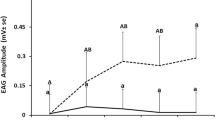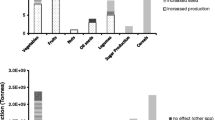Abstract
Varroa destructor Anderson and Trueman (Acari: Varroidae) is an obligatory ectoparasitic mite of honey bees. In view of limited success in mite control, the use of synthetic repellent was evaluated. The objective of the present study was to investigate the effect of common arthropod repellent N,N-diethyl-m-toluamide (DEET) on the chemosensing of the V. destructor and its hosts, the European honey bee (Apis mellifera L.), by electrophysiological and behavioural bioassays. In electrophysiological assays, the nurse headspace served as a positive stimulus for the V. destructor foreleg, whereas a queen headspace was used as a positive stimulus for honey bee antennae. Two effects of DEET on V. destructor host chemosensing were evaluated: short-term inhibition and long-term inhibition. The inhibition observed in the presence of DEET simultaneously with a positive stimulus was termed “short term inhibition”, while inhibition that occurred following the administration of the compound alone was termed “long term inhibition”. In V. destructor, DEET served as a long-term inhibitor to the response of the chemosensory organ to nurse bee headspace volatiles, whereas in honey bee, it caused short-term inhibition of antenna response to queen volatiles. Consistent with electrophysiological studies, DEET significantly inhibited host choice of mites, whereas even a 10 times higher dose did not alter honey bee behaviours (e.g. antennating, grooming, fanning etc.) or worker attraction to a queen. These data suggest that DEET may selectively disrupt the honey bee chemosensing of V. destructor.







Similar content being viewed by others
REFERENCES
Carroll, J.F., Benante, J.P., Klun, J.A., White, C.E., Debboun, M., Pound, J.M., Dheranetra, W. (2008) Twelve-hour duration testing of cream formulations of three repellents against Amblyomma americanum. Med. Vet. Entomol. 22, 144–151
Collins, A.M., Rubnik, W.L., Aguilar, J.I.C., Hellmich, R.L. (1996) Use of Insect Repellents for Dispersing Defending Honey Bees (Hymenoptera: Apidae). J. Econ. Entomol. 89, 608–613
Corbel, V., Stankiewicz, M., Pennetier, C., Fournier, D., Stojan, J., Girard, E., Dimitrov, M., Molgó, J., Hougard, J.M., Lapied, B. (2009) Evidence for inhibition of cholinesterases in insect and mammalian nervous systems by the insect repellent Deet. BMC Biol. 47, 1–11
Croset, V., Rytz, R., Cummins, S.F., Budd, A., Brawand, D., Kaessmann, H., Gibson, T.J., Benton, R. (2010) Ancient protostome origin of chemosensory ionotropic glutamate receptors and the evolution of insect taste and olfaction. PLoS Genet. 6, 1–20
Del Piccolo, F., Nazzi, F., Della Vedova, G., Milani, N. (2010) Selection of Apis mellifera workers by the parasitic mite Varroa destructor using host cuticular hydrocarbons. Parasitology 137, 967–973
Dickens, J.S., Bohbot, J.D. (2013) Mini review: Mode of action of mosquito repellents. Pesticide Biochem Physiol. 106, 149–155
Dillier, F.X., Fluri, P., Imdorf, A. (2006) Review of the orientation behaviour in the bee parasitic mite Varroa destructor: sensory equipment and cell invasion behavior. Revue Suisse de Zoologie. 113, 857–877
Ditzen, M., Pellegrino, M., Vosshall, B.L. (2008) Insect odorant receptors are molecular targets of the insect repellent DEET. Science 319, 1838–1842
Eliash, N. (2012) Learning and disrupting the chemical communication of Varroa destructor Anderson and Trueman. M.Sc. Thesis, Robert H. Smith Faculty of Agriculture, Food and Environment of the Hebrew University of Jerusalem, Israel
Eliash, N., Singh K. N., Kamer Y., Plettner, E., Soroker, V. (2014) Can we disrupt the sensing of honey bees by the bee parasite Varroa destructor? PLoS One, in press
Esslen, J., Kaissling, K.E. (1976) ZahlundVerteilungantennalerSen- sillen beider Honigbiene (Apis mellifera L.). Zoomorphologie 83, 227–251
Fabbro, S.D., Nazzi, F. (2013) From Chemistry to Behavior. Molecular Structure and Bioactivity of Repellents against Ixodes ricinus Ticks. PLoS One 8, 1–9
Harrewijn, P., van Oosten, A.M., Piron, P.G. (2001) Natural Terpenoids as Messengers: A Multidisciplinary Study of Their production, biological Functions and Practical Applications. Kluwer Academic Publishers., Netherlands
Kain, P., Boyle, S.M., Tharadra, S.K., Guda, T., Pham, C., Dahanukar, A., Ray, A.(2013) Odour receptors and neurons for DEET and new insect repellents. Nature 502, 507–514
Klun, J.A., Khrimian, A., Debboun, M. (2006) Repellent and deterrent effects of SS220, Picaridin, and DEET suppress human blood feeding be Aedes aegypti, Anopheles stephensi, and Phlebotomus papatasi . J Med. Entomol. 43, 34–39
Kraus, B. (1993) Preferences of Varroa jacobsoni for honey bee (Apis mellifera L.) of different ages. J Apic. Res. 32, 57–64
Le Conte, Y., Arnold, G., Trouiller, J., Masson, C., Chappe, B., Ourisson, G. (1989) Attraction of the parasitic mite Varroa to the drone larvae of honey bees by simple aliphatic esters. Science 245, 638–639
Lee, Y., Kim, S.H., Montell, C. (2010) Avoiding DEET through insect gustatory receptors. Neuron 67, 5551–5561
Martin, S.J. (2001) Biology and life history of Varroa mites. In: Webster TC, Delaplane KS. (Eds.) Mites of the Honey Bee. Hamilton: Dadant Sons. pp. 131–148
Missbach, C., Dweck, H.K., Vogel, H., Vilcinskae, A., Stensmyr, M.C., Hansson, B.S., Grosse-Wilde, E. (2014) Evolution of insect olfactory receptors. Elife 3, 1–22
Nazzi, F., Milani, N., Vedova, G.D., Nimis, M. (2001) Semiochemicals from larval food affect the locomotory behaviour of Varroa destructor. Apidologie 32, 149–155
Pellegrino, M., Steinbach, N., Stensmyr, M.C., Hansson, B.S., Vosshall, L.B. (2011) A natural polymorphism alters odour and DEET sensitivity in an insect odorant receptor. Nature 478, 511–514
Pernal, S.F., Baird, D.S., Birmingham, A.L., Higo, H.A., Slessor, K.N., Winston, M.L. (2005) Semiochemicals influencing the host-finding behaviour of Varroa destructor. Exp Appl Acarol. 37,1–26
Plettner, E., Gries, R. (2010) Agonists and antagonists of antennal responses of gypsy moth (Lymantria dispar) to the pheromone (+)-disparlure and other odorants. J. Agric. Food Chem. 58, 3708–3719
Rosenkranz, P., Aumeier, P., Ziegelmann, B. (2010) Biology and control of Varroa destructor. J Invertebr. Pathol. 103, S96-S119
Sandoz, J.C. (2011) Behavioral and neurophysiological study of olfactory perception and learning in honey bee. Front Syst Neurosci. 5,1-20
Schmidt, J.O., Johnston, A.N., Ginter, D.L., Spangler, H.G. (2003) Olfactory stimulation of Africanized honey bee (Hymenoptera: Apidae) attacks by insect repellents. J. Med. Entomol. 40, 275–278
Schroeder, A., Fritz, B., Weber, D., Wallner, K. (2007) A bee repellent endangers the quality of bee products. Apidologie 38, 495–496
Stanczyk, N.M., Brookfield, J.F., Ignell, R., Logan, J.G., Field, L.M. (2010) Behavioral insensitivity to DEET in Aedes aegypti is a genetically determined trait residing in changes in sensillum function. Proc. Natl Acad. Sci. USA. 107, 8575–8580
Stanczyk, N.M., Brookfield, J.F., Field, L.M., Logan, J.G. (2013) Aedes aegypti mosquitoes exhibit decreased repellency by DEET following previous exposure. PLoS One 8, 1–6
Syed, Z., Leal, W.S. (2008) Mosquitoes smell and avoid the insect repellent DEET. Proc. Natl Acad. Sci. USA. 105, 13598–13603
Torto, B., Carroll, M.J., Duehl, A., Fombong, A.T., Gozansky, T. K., Nazzi, F., Soroker, V., Teal, P.E.A. (2013) Standard methods for chemical ecology research in Apis mellifera. J. Apic. Res. 52, 1–34
Winston, M.L. (1987) The Biology of the Honey Bee. Harvard University Press., Cambridge, MA.
Acknowledgments
We thank Miss Yafit Brenner for providing us with dedicated program for behavioural analysis and Dr. Ada Rafaeli (Agricultural Research Organization, The Volcani Center) for stimulating discussions during manuscript preparation. We also wish to thank the anonymous reviewers for the valuable comments and suggestions. This project was supported by the Jewish Charitable Association, grant no 131-1740, and subsequently by grant from the Chief Scientist Ministry of Agriculture, grant no. 131-1815. We are also thankful to the Agricultural Research Organization, The Volcani Center, Bet Dagan, Israel for providing postdoctoral fellowship to Dr. Nitin Kumar Singh.
Author information
Authors and Affiliations
Corresponding author
Additional information
Effet du DEET sur la sensibilité chimique de l'abeille et de son parasite Varroa destructor
N,N-diéthyl-m-toulamide / Apis mellifera ligustica / électroantennogramme / essai biologique comportement / inhibition à court terme / inhibition à long terme
Der Effekt von DEET auf die Chemosensorik von Honigbienen und ihrem Parasiten Varroa destructor
N,N-Diethyl-m-Toulamid / Apis mellifera ligustica / Elektroantennogramm / Verhaltensbiotest / Kurzzeit-Inhibition / Langzeit-Inhibition
Manuscript editor: Peter Rosenkranz
Rights and permissions
About this article
Cite this article
Singh, N.K., Eliash, N., Kamer, Y. et al. The effect of DEET on chemosensing of the honey bee and its parasite Varroa destructor . Apidologie 46, 380–391 (2015). https://doi.org/10.1007/s13592-014-0330-1
Received:
Revised:
Accepted:
Published:
Issue Date:
DOI: https://doi.org/10.1007/s13592-014-0330-1




